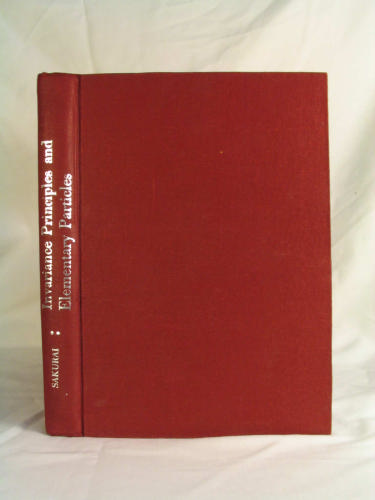Invariance Principles and Elementary Particles download
Par walker bettie le mercredi, juillet 27 2016, 05:32 - Lien permanent
Invariance Principles and Elementary Particles. Sakurai J.J.

Invariance.Principles.and.Elementary.Particles.pdf
ISBN: 0691079870,9780691079875 | 338 pages | 9 Mb

Invariance Principles and Elementary Particles Sakurai J.J.
Publisher: PUP
So what does it mean for They obey what are called Fermi-Dirac statistics: they can't occupy all the same quantum states--they have to differ from one another on at least something, often the spin; they are governed by Pauli's exclusion principle. The Higgs boson plays a key role in the Standard Model: it is related to the unification of the electromagnetic and weak forces, explains the origin of elementary particle masses, and provides a weakly coupled way to . One of the difficulties here concerns how the PDFs evolve with a change in the wavelength of the probe particle. Galileo Galilei first described this principle in 1632 in his Dialogue Concerning the Two Chief And because materials consist of elementary particles, it is clear that the presence of (elementary) particles affects the speed of light. �Galilean invariance or Galilean relativity is a principle of relativity which states that the fundamental laws of physics are the same in all inertial frames. No matter how we word the debate, the conclusion is the same: the Higgs field is not, in principle, the universal giver of mass to all the elementary particles of nature. The symposium began with a focus on work at Dubna, starting with the unveiling of a monument to Vladimir Veksler, who invented the principle of phase stability (independently from Edwin McMillan in the US) and founded the 10 GeV Synchro- phasotron in The dipole moment of fundamental particles violates both parity and time-reversal invariance. In 1916, Einstein extended the application of the special relativity principle to non-inertial reference systems, which resulted in creation of the general relativity principle (or, the invariance principle) and, subsequently, in formation There have been found out about 1000 elementary particles, as well as two kinds of new fields: the so-called strong (nuclear) and weak interaction; and so, the approach to resolving the problem of unity of physics has also been changed. There are some apparent (and somewhat controversial) counter-examples: the cosmological constant problem is a much more severe 'fine-tuning' problem which may be explained anthropically rather than through more fundamental principles. Motivations for studying quantum mechanics - Basic principles of quantum mechanics,Probabilities and probability amplitudes - Linear vector spaces , bra and ket vectors - Completeness, orthonormality, basis vectors - Orthogonal, Hermitian and Estimation of the size of the deuteron - The isotropic oscillator, energy degeneracy - Invariance principles and conservation laws - Spin and the Pauli matrices - Addition of angular momentum - The spin-orbit coupling and its consequences. Given that these modes of excitation satisfy the principles of quantum theory, they are often dubbed 'excitation quanta'. The Democritean vision of elementary particles as miniature snooker balls, however, has been somewhat vitiated by quantum theory, and it is not merely the classical notion of a particle as a localisable entity which has been undermined, but the mereological notion that a composite system has a unique decomposition into elementary entities. Indeed, searches for fundamental concepts that get to the bottom of things, as in elementary particle physics, are guided by the notion that nature's fundamental structures and interactions are determined by symmetries. This is what causes light rays to break in the transition from air to glass. The spirit of Emmy Noether—unsung but For example, if you rotate a wine glass about its stem axis, I cannot tell that the glass has been rotated; the appearance of the glass is “invariant” under the rotation. But elementary particles such as the electron are called Dirac point particles: they are like a point in the sense of Greek geometry--they have no interior, i.e., no width, no breadth, no length, no insides.